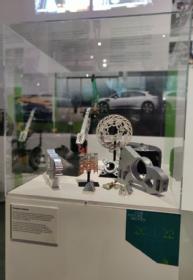WMG News
Warwick student projects showcased at Our Future Moves
Students from across WMG and the School of Engineering have been showcasing their work at the Our Future Moves exhibition at the Coventry Transport Museum.
The exhibition is filled with contraptions, inventions, innovations and demonstrations showing the mechanisms and machinations of all things that move. The students have contributed several pieces to the exhibition that showcase their skills and imagination when it comes to futuristic transport.
Satellites
There are satellites from WUSat, the student team who are building nanosatellites to explore space and improve communications on earth. The students are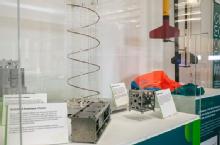 working on satellites that can orient themselves in space accurately enough to monitor wildlife populations on earth. Find out more here: OFM5: City Ecology // Our Environment — Culture Space Coventry
working on satellites that can orient themselves in space accurately enough to monitor wildlife populations on earth. Find out more here: OFM5: City Ecology // Our Environment — Culture Space Coventry
There are racing car components from Warwick Racing, the team that build a functioning electric race vehicle to compete in the Formula Student competition each year.
Submarines
The third student project on display is the Warwick Sub Team’s human-powered submarine. The students are tasked with designed and building the submarine to compete against other universities. The competition is usually held every-other-year at the US Naval Base in Cardarock, Maryland in the US, but due to the Covid19 pandemic it was held virtually this year. The students have won many accolades throughout the years. This year the team received Honourable Mentions’ in the ‘Manoeuvring and Control Subsystem Design Challenge’ and the ‘Thrust Production Subsystem Design Challenge’ categories.
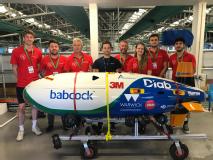 Sharing her experiences of the Warwick Sub team, Verena Oetzmann, Team Leader in 2016-2017, says: “In addition to all the challenges that we women in engineering face, being the female leader of an otherwise all male team was a demanding but very rewarding role. The lessons I have learnt throughout my time, coupled with the many skills procured along the way, have been invaluable as preparation for working life after university.
Sharing her experiences of the Warwick Sub team, Verena Oetzmann, Team Leader in 2016-2017, says: “In addition to all the challenges that we women in engineering face, being the female leader of an otherwise all male team was a demanding but very rewarding role. The lessons I have learnt throughout my time, coupled with the many skills procured along the way, have been invaluable as preparation for working life after university.
“Despite being the most difficult venture that I have undertaken at university, it is certainly among the most enjoyable, rewarding and memorable experiences I have ever had.”
Professor Ian Tuersley, Project Director for Warwick Sub, adds: “It is clear that our students who are fortunate enough to be involved in the International Submarine Race (ISR) competitions enjoy the experience immensely and value the additional benefits that these unique opportunities provide them.
“However, from the point of view of an educator, in addition to the excellent experience there is tangible empirical evidence that the requirements of the competitions – including the necessary enforcement of real-world deadlines and constraints focuses their work and personal development on areas that more traditional University learning is not easily able to deliver. Skills such as team-working, project management, problem solving, budgetary awareness and leadership are essential if success is to be achieved in the competitions – and these are exactly the skills and behaviours that are most highly valued by potential employers.”
The students involved in all these projects learn how to apply their knowledge and gain experience of a real project, run in an industrial style. They make fantastic role models for young people, including Jack Moore (a former Sub Team member) whose profile is also part of the exhibition.
Our Future Moves runs until 31st October at the Coventry Transport Museum, or explore the online exhibition here: https://transport-museum.com/events/1491/our_future_moves
WMG Professors help tackle Net Zero solutions ahead of COP26
Ahead of COP26, voices across the political spectrum and from a range of leading UK universities have come together to produce a unique collection of essays focusing on Net Zero solutions.
Each is co-written by an academic and a Parliamentarian and sets out the areas where work is still needed on climate policy and demonstrates how readily to hand many policy and technical solutions are. It showcases the strength of UK science and research and the level of cross-party support for climate action.
Two WMG Professors have produced essays as part of the series. Professor David Greenwood together with Lilian Greenwood MP, has written ‘Driving the electric vehicle revolution’, and Professor Kerry Kirwan has, with Ben Lake MP, written ‘Overcoming barriers to the circular economy’.
Caroline Lucas MP, Chair of the APPG on Climate Change, explains: “The APPG on Climate Change was founded to coincide with the passing of the 2008 Climate Change Act – a vote that achieved almost unanimous support from across the political spectrum. As current Chair of the APPG on Climate Change, I see great value in striving to maintain and build upon this cross-party consensus where possible. We won’t all agree on the necessary course of action in each sector. And we may not even agree on the speed or scale with which it is necessary to reduce emissions. But we share a common conviction that the climate crisis is a challenge that can and must be surmounted. Deeper engagement between parliamentarians and the scientific community is a vital step in ensuring that we do. It is in that spirit that I fully endorse the work that has gone into producing this collection of essays.”
 In his essay, co-authored with Lilian Greenwood MP, Professor David Greenwood, CEO of WMG High Value Manufacturing Catapult at the University of Warwick explains: “Whilst the coronavirus pandemic has resulted in devastating personal and economic impacts, it has also caused us to challenge some of our preconceptions. The public has experienced clean air as a result of reduced transport and industrial emissions. People have taken to their bikes in record numbers and with the trials of rental e-scooters there’s a real opportunity for them to replace car and public transport usage for short journeys - at least in good weather.
In his essay, co-authored with Lilian Greenwood MP, Professor David Greenwood, CEO of WMG High Value Manufacturing Catapult at the University of Warwick explains: “Whilst the coronavirus pandemic has resulted in devastating personal and economic impacts, it has also caused us to challenge some of our preconceptions. The public has experienced clean air as a result of reduced transport and industrial emissions. People have taken to their bikes in record numbers and with the trials of rental e-scooters there’s a real opportunity for them to replace car and public transport usage for short journeys - at least in good weather.
“These behavioural shifts, along with the persistent drivers of air quality and climate change reinforce the shift to EVs.”
 Kerry Kirwan, WMG’s Professor of Sustainable Materials and Manufacturing explains: “Given the continued focus on how we use our limited planetary resources, the potential for green business models and practices to help our economic recovery post-pandemic and the imminence of COP26, it is great to see such a breadth of collected thinking coming together in this publication – it was a really valuable exercise that I am very pleased to have been part of”.
Kerry Kirwan, WMG’s Professor of Sustainable Materials and Manufacturing explains: “Given the continued focus on how we use our limited planetary resources, the potential for green business models and practices to help our economic recovery post-pandemic and the imminence of COP26, it is great to see such a breadth of collected thinking coming together in this publication – it was a really valuable exercise that I am very pleased to have been part of”.
Read the report and essays in full here: https://www.policyconnect.org.uk/research/net-zero-exchanges-connecting-policy-and-research-climate-action
About the APPCCG
The All-Party Parliamentary Climate Change Group runs events and activities in parliament with the purpose of advancing understanding of policy issues surrounding climate change and enabling cross-party discussion and action on climate policy.
This is not an official feed of the House of Commons or the House of Lords. It has not been approved by either House or its committees. All-Party Parliamentary Groups, forums and commissions are informal groups of Members of both Houses with a common interest in particular issues. The views expressed in the webpages are those of the groups.
About Policy Connect
Policy Connect is a membership-based, not-for-profit, cross-party think tank.
We bring together parliamentarians and government in collaboration with academia, business and civil society to inform, influence and improve UK public policy through debate, research and innovative thinking, so as to improve peoples’ lives.
We lead and manage an extensive network of parliamentary groups, research commissions, forums and campaigns. We are a London living wage and disability confident employer and a Member of Social Enterprise UK, and have been operating since 1995. Our work focuses on key policy areas including: health & accessibility; education & skills; industry, technology & innovation; and sustainability.
We shape policy in Westminster through meetings, events, research and impact work.
Pioneering industry collaboration accelerates hydrogen refuelling innovation for HGVs
WMG is working with Midlands-based SME Hy-Met Limited and Logan Energy to deliver the Hydrogen Prototype Equipment for Refuelling (HyPER) project.
Together, the consortium will develop a next-generation hydrogen flowmeter for refuelling Heavy Goods Vehicles (HGVs). These will be used for hydrogen refuelling systems, and will be lightweight, smaller, more cost effective and more accurate than existing instruments.
refuelling systems, and will be lightweight, smaller, more cost effective and more accurate than existing instruments.
This follows recent funding from the UK Government’s Department of Transport zero emission road freight trials through Innovate UK. The project value totals around £170,000.
The new meter will also be easier to manufacture and maintain than current options on the market.
The project aims to reduce the cost of hydrogen refuelling and enable the wider adoption of hydrogen by transport fleets and other users.
Nishal Ramadas, co-founder and CEO of Hy-Met, said: “Since launching Hy-Met in January, we’ve been motoring ahead with our plans to help with the transition to net zero. With our innovative measurement platform, Hy-Met is combining our deep hardware and software expertise to tackle some of the complex measurement challenges facing the hydrogen sector.
“When building the consortium, we knew we needed partners with detailed knowledge of the requirements for hydrogen refuelling and advanced manufacturing and prototyping capabilities.
“Our choice of project partners was clear and we are very happy Logan Energy and WMG have joined us in tackling this refuelling challenge.”
Bill Ireland, Chief Executive at Logan Energy, said: “Using hydrogen to power lorries is one of the key steps towards helping Scotland and the UK tackle the climate emergency.
“Making the switch from burning diesel to using hydrogen will cut the amount of carbon dioxide and other harmful gases being pumped into the atmosphere.
“There are a number of advancements we need to take before hydrogen becomes commonplace on our roads and one of the crucial elements is making it cheap and easy to refuel.
“For nearly three decades Logan Energy has been at the forefront of developing new and innovative hydrogen technologies both here in the UK and abroad. This collaborative partnership with Hy-Met and WMG is another step towards helping the UK grow its capabilities within the hydrogen industry and the drive to net-zero.”
Dmitry Isakov, Assistant Professor at WMG, said: “Securing this funding from the Department of Transport through Innovate UK will help us to accelerate our work. Working alongside Logan Energy and Hy-Met will allow us all to combine our knowledge and expertise to develop an industry-leading hydrogen flowmeter.”
New National Electrification Skills Framework and Forum could put the UK at the forefront of the green revolution
§ In order to meet Net Zero carbon commitments the UK needs to invest in technologies for electrification, meaning many employers and employees will need to up-skill, re-skill and new-skill to meet the demand
§ A national approach to re-skilling, up-skilling and new-skilling the workforce for the electric revolution has been established by WMG, University of Warwick alongside the Faraday Institution and the High Value Manufacturing Catapult in their report: ‘The Opportunity for a National Electrification Skills Framework and Forum’
§ The report emphasises the need for education providers to collaborate on offerings, industry to define their needs, and enables training providers and employers to collaborate on the development of courses required to enable workforces to meet the challenges of the electric revolution and put the UK in a position as a world leader
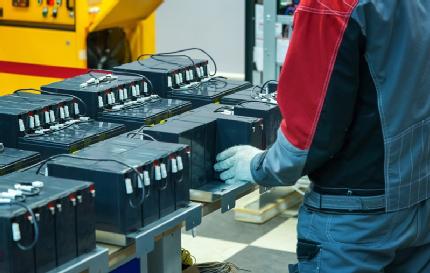 New technologies and a skilled workforce are both essential to meet the challenge of net carbon zero. To ensure the UK is ready for the transition, a new skills framework has been created by WMG - University of Warwick, The Faraday Institution and the High Value Manufacturing Catapult.
New technologies and a skilled workforce are both essential to meet the challenge of net carbon zero. To ensure the UK is ready for the transition, a new skills framework has been created by WMG - University of Warwick, The Faraday Institution and the High Value Manufacturing Catapult.
The Government’s plan to ban sales of new diesel and petrol cars by 2030 has pushed the automotive sector, along with many others, to rapidly adopt, and develop, electrified products at a rate that will continue to increase for the next 10 to 15 years. How transport and utility sectors can re-skill, up-skill and new-skill their workforce to meet skills demand at the point of need has been outlined in ‘The Opportunity for a National Electrification Skills Framework and Forum’, authored by WMG, University of Warwick; the High Value Manufacturing Catapult; and the Faraday Institution.
Aimed at employers, training providers, accrediting organisations and learners the report discusses how industry engagement, along with educational collaboration rather than competition, will be key in putting the UK at the forefront of the electric revolution and securing future work opportunities.
The Framework recommends the use of short and long courses, as well as continuing professional development, to deliver the competency sets to meet electrification goals across a range of sectors. The framework currently considers vehicle electrification as well as battery manufacture, power electronics, motors and drives, and learnings will next be extended to rail, aviation and utilities.
Through engagement with industry participants and educational providers, the report identifies the key principles and skills needed to make the UK a world leader in electrification. By re-skilling, up-skilling and providing routes through from education to enable new-skills, employees can progress in their career and companies provide a viable way of managing and developing the skills of workforces in line with business objectives.
In order for the UK to successfully transition to an electrified and Net Zero future it is essential that all aspects of industry and education collaborate. The forum provides an opportunity for not only different companies from multiple sectors to work together, but also for training providers across the UK to collaborate and crystallise the need for training, enabling the right courses to be offered at the point of need. Overall the forum will help create skills development opportunities, and make the electric shift as smooth and sustainable as possible.
forum provides an opportunity for not only different companies from multiple sectors to work together, but also for training providers across the UK to collaborate and crystallise the need for training, enabling the right courses to be offered at the point of need. Overall the forum will help create skills development opportunities, and make the electric shift as smooth and sustainable as possible.
Professor David Greenwood, CEO of WMG High Value Manufacturing Catapult at the University of Warwick comments:
“Electrification of automotive and aerospace industries, as well as the establishment of UK battery production facilities (gigafactories) represents a considerable industrial opportunity for the UK and one where having a workforce with the required skills and capabilities will be essential for the nation to compete successfully on the European stage.
“As these sectors transform to fully electric products, we have a proposed national plan for electrification skills, through which we will define a framework to deliver a workforce with the required skills and capabilities to deliver the sectoral technology roadmaps. This focus will be essential for the sector to develop thrive in a highly competitive global industry.
“We are proud to launch this forum, through which the electrification skills framework will be shaped by the wisdom and direction of automotive technologists, educators, accrediting bodies and training providers. It will provide a framework for a national skills programme, delivering at a regional level according to industrial need.”
Tony Harper, the Director of the Faraday Battery Challenge at UK Research and Innovation comments:
"UK industry is undergoing an exciting and rapid transformation to fulfil the UK Government’s 2050 Net Zero commitments. This once-in-a-generation, global technological revolution leaves competency gaps at all job levels, particularly in engineering and manufacturing roles which will need to be filled with specific education and training.
“We are pleased to make available a UK-wide framework and forum to ‘re-skill, up-skill and new-skill’ the UK engineering and manufacturing workforce, a major step forward to ensuring the right skills are in place at the right time.
“Our report defines the training and investment in people, education and skills that will allow the UK to Build Back Better and secure greener jobs in a flourishing UK electrification sector.”
Business Minister Lee Rowley said:
“We are leading the world in developing the latest technology in electric vehicles and today’s report demonstrates the work that employers and industry organisations can collaborate on to keep the UK in that pole position.
“This revolution in our automotive sector will create thousands of jobs, building on our rich industrial heritage and giving opportunities to our talented and highly-skilled workforce – all this will be essential as we work to eliminate our contribution to climate change by 2050.”
§ The report ‘The Opportunity for a National Electrification Skills Framework and Forum’ will be available online from 22 September at: https://hvm.catapult.org.uk/reports/national-electrification-skills-framework
§ Information on course materials will be available from 22 September at: https://hvm.catapult.org.uk/resources/courses
ENDS
22 SEPTEMBER 2021
NOTES TO EDITORS
To get involved in the electrification skills forum as a provider or employer please e-mail: electrification-skills@hvm.catapult.org.uk
High-res images available at:
https://warwick.ac.uk/services/communications/medialibrary/images/september_2021/nesf_1.jpeg
https://warwick.ac.uk/services/communications/medialibrary/images/september_2021/nesf_2.jpeg
https://warwick.ac.uk/services/communications/medialibrary/images/september_2021/nesf_0033.jpeg
Caption: The National Electrification Skills Framework and Forum aims to support new technologies and a skilled workforce in transport, battery manufacturing, and beyond.
For further information or an embargoed copy of the report please contact:
Peter Thorley
Media Relations Manager (Warwick Medical School and Department of Physics) | Press & Media Relations | University of Warwick
Email: peter.thorley@warwick.ac.uk
Mob: +44 (0) 7824 540863
About WMG, University of Warwick
WMG is a world leading research and education group, transforming organisations and driving innovation through a unique combination of collaborative research and development, and pioneering education programmes.
As an international role model for successful partnerships between academia and the private and public sectors, WMG develops advancements nationally and globally, in applied science, technology and engineering, to deliver real impact to economic growth, society and the environment.
WMG has a track record of impact and collaborative R&D in batteries, through their Energy Innovation Centre. A unique UK facility which is capable of producing full-size prototype battery cells in sufficient quantities for industrial testing. The Centre is focused on identifying and demonstrating battery chemistries with higher energy densities and improved safety while achieving the cost criteria set by the automotive industry. This technology is transferred to other sectors including, aerospace, marine, rail and static energy storage for home applications.
WMG’s education programmes focus on lifelong learning of the brightest talent, from the WMG Academies for Young Engineers, degree apprenticeships, undergraduate and postgraduate, through to professional programmes.
An academic department of the University of Warwick, and a centre for the HVM Catapult, WMG was founded by the late Professor Lord Kumar Bhattacharyya in 1980 to help reinvigorate UK manufacturing and improve competitiveness through innovation and skills development.
About the Faraday Institution
The Faraday Institution is the UK’s independent institute for electrochemical energy storage research, skills development, market analysis, and early-stage commercialisation. Bringing together expertise from universities and industry, the Faraday Institution endeavours to make the UK the go-to place for the research and development of new electrical storage technologies for both the automotive and wider relevant sectors.
The Faraday Institution is funded by the Engineering and Physical Sciences Research Council (EPSRC) as part of UK Research and Innovation. Headquartered at the Harwell Science and Innovation Campus, the Faraday Institution is a registered charity with an independent board of trustees.
The Faraday Battery Challenge aim is to develop and manufacture batteries for the electrification of vehicles to help UK businesses seize the opportunities presented by the move to a low carbon economy. The challenge is split into three elements: research, innovation, and scale-up.
About High Value Manufacturing Catapult
The High Value Manufacturing Catapult has an established record as the UK’s principal agent of industrial transformation. Working through seven centres of innovation, the HVM Catapult is creating the conditions for UK economic growth by enabling UK manufacturers to investigate new technologies and processes and achieve performance and productivity improvements through innovation.
Established by Innovate UK, the HVM Catapult bridges the gap between business and academia, helping to turn great ideas into commercial realities by providing access to world-class research, development facilities and expertise that would otherwise be out of reach for many businesses in the UK. The HVM Catapult prides itself on helping businesses to transform the products they sell, the way they make them and the skills of their workforce to remain competitive in a global marketplace.
22 September 2021
Consortium established to tackle decarbonisation of cross-Channel ferry fleet
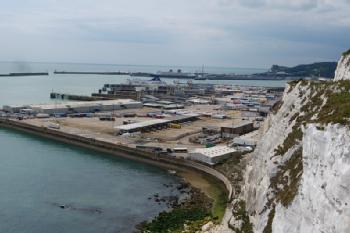 WMG at the University of Warwick is playing a key part in a new research project supporting the UKs pledge to achieve net-zero by 2050.
WMG at the University of Warwick is playing a key part in a new research project supporting the UKs pledge to achieve net-zero by 2050.
The seven-month project, entitled the Dover Clean Ferry Power, is a collaboration between the Port of Dover, P&O Ferries, WMG and Schneider Electric, led by Kent Business School at the University of Kent.
The project, which is part of a £20 million programme funded by the Department for Transport, will investigating the decarbonisation of the cross-Channel ferry fleet and in turn support the delivery of the Port of Dover Air Quality Action Plan.
Currently, Port of Dover vessels spend energy through in-harbour activity, open sailing and on-vessel services (such as heating, lighting and hospitality). Some vessels are hybrid; self-charging on-board batteries whilst in open sailing and then using the battery charge whilst in-harbour.
This project will model ferry operations at Dover to establish energy requirements, CO2 effects, air quality and running costs, using this to evaluate technical solutions for both ferries and the port, to accelerate the move to net zero. Insights gained may then have the potential to extend to cruise and cargo operators, as well as adaptation of experienced vessels.
Researchers and engineers at WMG High Value Manufacturing Catapult Centre will be undertaking all of the battery modelling and analytics, plus energy and CO2 modelling for the port of Dover and for vessels using the port– which will impact the locals as well as the environment more widely.
Phil Whiffin, WMG Head of Energy Applications Group, explains: “This project builds on our existing zero emission transport expertise and allows us to apply the MIMO (Multi-Input Multi-Output) modelling technique developed by Dr Andrew McGordon to investigate the complex operations of a port. It will support investment and operation decisions for Dover and the ferry operators and ensure the optimum strategy is in place to move towards net-zero. Dover is an essential trade gateway for the UK so this is a project of great strategic importance and we are pleased to be part of this great consortium.”
Simon Barnes, Project Manager and Funding & Partnership Development Manager within the University of Kent’s Research & Innovation Operations, said: ‘For the University of Kent, this new project builds on a previous successful work with the Port of Dover and is an excellent example of a collaborative project with the University, industry partners and consumers.
‘It is our unified aim to investigate potential avenues that can lead to reductions in carbon emissions as part of the national priority of net-zero. The University of Kent is dedicated to the endeavour through a series of initiatives, with the Dover Clean Ferry Power project as a prime example of the role we play regionally and in applying intensive research to vital national goals.’
ENDS
Notes to Editors
(1)
Clean Maritime Demonstration Competition
The Dover Clean Ferry Power Project is part of the Clean Maritime Demonstration Competition, funded by the Department for Transport and delivered in partnership with Innovate UK.
Announced in March 2020, and part of the Prime Minister’s Ten Point Plan to position the UK at the forefront of green shipbuilding and maritime technology, the Clean Maritime Demonstration Competition is a £20m investment from government alongside a further c.£10mfrom industry to reduce emissions from the maritime sector. The programme is supporting 55 projects across the UK, including projects in Scotland, Northern Ireland and from the South West to the North East of England. As set out in the Clean Maritime Plan (2019), Government funding has been used to support early-stage research relating to clean maritime. The programme will be used to support the research, design and development of zero emission technology and infrastructure solutions for maritime and to accelerate decarbonisation in the sector.
UK’s first live micromobility event takes place at WMG, University of Warwick
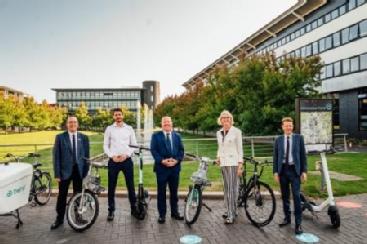 Micromobility refers to small lightweight efficient vehicles, which can be used to make short distance journeys.
Micromobility refers to small lightweight efficient vehicles, which can be used to make short distance journeys.
Types of micromobility vehicles we could see in our communities include bikes, hover boards, e-bikes and e-scooters. They can be used to save time, avoid congestion, remove parking conundrums and most importantly they use much less energy than a car, therefore contributing towards the Government’s zero-carbon goals.
The future of micromobility is incredibly topical, and to bring together all aspects of it WMG, at the University of Warwick, hosted the UK’s first live micromobility event, bringing together manufacturers in the micromobility sector, regional transport authorities; city councils and local authorities; Government agencies; research organisations and more.
The event not only saw the demonstration of many new exciting and existing micromobility vehicles from e-scooters to e-cargo bikes, but also outlined the opportunities for the UK to lead this sector in battery development and recycling, human factors and behavioural change, materials development and more.
It was also an opportunity to address the challenges the sector faces particularly around lack of infrastructure, policy and regulation.
Programme Director John Fox, from WMG, University of Warwick comments:
“Despite progress on electrification, transport emissions are actually increasing; Micromobility is essential if we are to achieve net zero emissions from this sector. With around 70% of journeys in the UK under 5 miles, Micromobility vehicles can have a huge impact on our emissions. They use typically 5% of the energy of an Electric vehicle to make trips, and their manufacture is also significantly less carbon-intensive.
“There are many other benefits Micromobility offers too, including air quality improvements, greater footfall in highstreets, and taking up much less space than a car to move the same number of people which releases more space in urban areas for other things.
“The conference touched on many of the key issues, including how to make Micromobility safe, accessible, integrated and attractive to new users, and highlighted the need for coordination between government, local authorities and industry. WMG announced our ‘UK Micromobility roadmap” to support this coordination, being developed with Cenex and being progressed through consultation and workshops sessions over the next six months, so watch this space!”
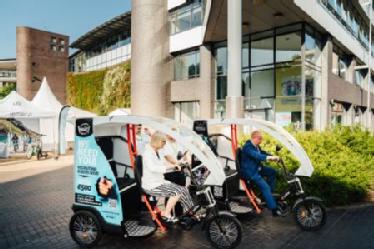 Margot James, Executive Chair of WMG, University of Warwick adds:
Margot James, Executive Chair of WMG, University of Warwick adds:
“As a leader in the electrification of transport, WMG, University of Warwick, is at the forefront in the development of high-quality, safe Micromobility vehicles. We are conducting trials with vehicle and infrastructure manufacturers on the Warwick campus, and supporting testing and development of new vehicles and systems in our labs. We’re also working closely with our local and regional authorities to make travel to and from our campus more sustainable, which includes supporting commutes by Micromobility with improved infrastructure and facilities on arrival.”
Andy Street, the Mayor of the West Midlands, said:
“As the home of the green industrial revolution, micromobility has a key role to play in the West Midlands as we look to tackle air pollution to help us reach our #WM2041 climate goal. Earlier this year we launched West Midlands Cycle Hire across eight towns and city centre - with more than 100,000 journeys taken on the bikes in just a few months – and we are also trialling e-scooters across the region, with more than 550,000 trips taken in Birmingham alone over the past year.
“But despite this successful start of both schemes we are of course always open to more innovation and improvement. That’s why it has been brilliant to have the micromobility industry here in the West Midlands, and it has been eye-opening to see what the industry has to offer.”
Councillor Jim O’Boyle, cabinet member for jobs, regeneration and climate change said:
“The innovation shown at the event is a result of the incredible engineering and manufacturing talent that can only be found in Coventry. Our city is leading the green industrial revolution and is at the heart of developing new forms of transport, from the micromobility solutions we have seen at the event to the innovative Coventry Very Light Rail, set to transform how many of us travel.
“It’s great to be with our partners at WMG to raise awareness of the ground-breaking work our city is contributing to the future of clean, green transport.”
ENDS
8 SEPTEMBER 2021
NOTES TO EDITORS
High-res images available at:
https://warwick.ac.uk/services/communications/medialibrary/images/july_2021/070921wuweb-12.jpg
Caption: A WMCA bike stand
Credit: WMG, University of Warwick
https://warwick.ac.uk/services/communications/medialibrary/images/july_2021/070921wuweb-247.jpg
Caption: People trialling some micromobility vehicles at the event
Credit: WMG, University of Warwick
https://warwick.ac.uk/services/communications/medialibrary/images/july_2021/070921wuweb-53.jpg
Caption: From left to right: Professor Robin Clark, Dean of WMG at the University of Warwick, John Fox – Programme Director for Micromobility at WMG, Cllr Jim O’Boyle - cabinet member for jobs, regeneration and climate change at Coventry City Council, Margot James- Executive Chair of WMG at the University of Warwick, Mayor of the West Midlands Andy Street
Credit: WMG, University of Warwick
https://warwick.ac.uk/services/communications/medialibrary/images/july_2021/070921wuweb-65.jpg
Caption: Margot James- Executive Chair of WMG at the University of Warwick with Mayor of the West Midlands Andy Street
Credit: WMG, University of Warwick
https://warwick.ac.uk/services/communications/medialibrary/images/july_2021/070921wuweb-62.jpg
Caption: From left to right: Cllr Jim O’Boyle - cabinet member for jobs, regeneration and climate change at Coventry City Council, Margot James- Executive Chair of WMG at the University of Warwick and Andy Street - Mayor of the West Midlands
Credit: WMG, University of Warwick
https://warwick.ac.uk/services/communications/medialibrary/images/july_2021/070921wuweb-69.jpg
Caption: Mayor Andy Street with some of the micromobility vehicles showcased
Credit: WMG, University of Warwick
https://warwick.ac.uk/services/communications/medialibrary/images/july_2021/070921wuweb-43.jpg
Caption: Margot James – Executive Chair of WMG, and Cllr Jim O’Boyle from Coventry City Council have a go in a Hail bike
Credit: WMG, University of Warwick
https://warwick.ac.uk/services/communications/medialibrary/images/july_2021/070921wuweb-50.jpg
Caption: Margot James – Executive Chair of WMG at the University of Warwick on a Hail bike
Credit: WMG, University of Warwick
https://warwick.ac.uk/services/communications/medialibrary/images/july_2021/070921wuweb-222.jpg
Caption: People at a West Midlands Transport Hub with a West Midlands Cycle Hire bike and a VOI e-scooter
Credit: WMG, University of Warwick
https://warwick.ac.uk/services/communications/medialibrary/images/july_2021/070921wuweb-72.jpg
Caption: A West Midlands Cycle Hire bike
Credit: WMG, University of Warwick
For further information please contact:
Alice Scott
Media Relations Manager – Science
University of Warwick
Tel: +44 (0) 7920 531 221
E-mail: alice.j.scott@warwick.ac.uk
UK-based consortium established to develop prototype solid-state batteries
MOU signed between Johnson Matthey, Faraday Institution, Britishvolt, Oxford University, UK Battery Industrialisation Centre, Emerson & Renwick and University of Warwick
HARWELL, UK (19 August 2021) A consortium of seven UK-based organisations has signed a memorandum of understanding to combine ambitions to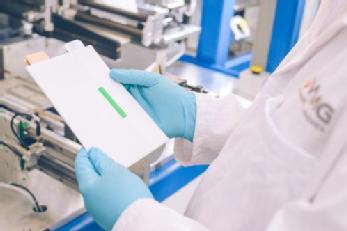 develop world-leading prototype solid-state battery technology, targeting automotive applications.
develop world-leading prototype solid-state battery technology, targeting automotive applications.
Solid-state batteries offer significant potential advantages over conventional lithium-ion batteries and could be transformational in meeting the UK’s net zero commitments through the electrification of transport. The successful outcome of the collaboration would be to harness and industrialise UK academic capability to produce cells using highly scalable manufacturing techniques that leapfrog the cost-effectiveness and performance achieved elsewhere.
The consortium comprises the following world-leading organisations in battery research, development and manufacturing:
· Faraday Institution – the UK’s independent institute for electrochemical energy storage research, which has led the consortium’s formation and will lead its development.
· Britishvolt – the UK-based Gigaplant developer, with a site in NE England.
· E+R (Emerson & Renwick) – a world leading designer of manufacturing equipment.
· Johnson Matthey – a global leader in sustainable technologies and the UK’s leading battery materials business.
· Oxford University – that leads the Faraday Institution’s solid-state battery project (SOLBAT) and provides the necessary scientific understanding to the consortium.
· UK Battery Industrialisation Centre – the pioneering battery manufacturing development facility to enable UK battery manufacturing scale-up and facilitate upskilling in the battery sector.
· WMG, University of Warwick – leaders in battery R&D and initial scale-up capability, as well as academic and apprenticeship skills development.
The preliminary design for a prototyping facility has been developed. Sources of funding are currently being sought.
Minister for Investment Lord Grimstone said: “Collaboration between industry, government and our world-leading academic institutions is putting the UK at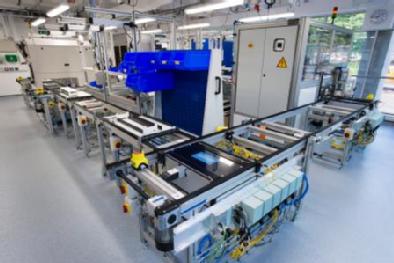 the forefront of global efforts to develop innovative automotive technologies, such as solid-state batteries.
the forefront of global efforts to develop innovative automotive technologies, such as solid-state batteries.
“It is the work of our internationally-renowned research and development base, like those brought together by this consortium, that will give us the tools needed to forge a strong and sustainable future for the automotive sector and increase our contribution to combatting climate change.”
“I am delighted to be able to announce the formation of this unique consortium for the advancement of solid-state battery prototyping that includes leading UK-based organisations at many stages in the value chain,” said Professor Pam Thomas, CEO of Faraday Institution. “Our leadership in this venture signals a move towards a role that the Faraday Institution will increasingly play as a trusted convener of significant partnerships between UK industry and academia as a route to commercialise breakthrough science emerging from our research programmes to maximise UK economic value.”
Solid-state batteries (SSBs) offer significant potential advantages over existing lithium-ion battery technologies, including the ability to hold more charge for a given volume (leading to increased electric vehicle (EV) range) and reduced costs of safety-management. Early deployment of SSBs is likely to be in consumer electronics, niche automotive applications and unmanned aerospace, before being used in broader EV markets. The Faraday Institution forecasts that, in 2030, SSBs are likely to take a 7% share of the global consumer electronics battery market and a 4% share of the EV battery market[1]. Global SSB revenues from sales to EV manufacturers are expected to reach $8 billion by 2030[2] and then grow rapidly to 2040 and 2050 when the market is expected to become extensive.
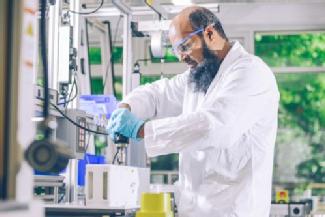 However, there are fundamental scientific challenges that need to be addressed before high power SSBs with commercially relevant performance can be realised. The Faraday Institution’s SOLBAT project has made considerable progress in addressing these challenges over the last three years.
However, there are fundamental scientific challenges that need to be addressed before high power SSBs with commercially relevant performance can be realised. The Faraday Institution’s SOLBAT project has made considerable progress in addressing these challenges over the last three years.
The construction of the one-of-a-kind facility being developed by the collaboration will enable SSB technology to emerge from UK university laboratories. It will allow larger cells to be produced using scalable manufacturing techniques that will be improved iteratively through deep investigation of the causes of problems that emerge during manufacture and testing of prototype batteries. This will leverage the collective knowledge of Faraday Institution SSB researchers and the industrial partners.
Christian Gunther, CEO, Battery Materials at Johnson Matthey comments, “The realisation of a prototype solid-state battery cell will be a great achievement for the UK battery industry, and this consortium will be a critical enabler for delivering this milestone. Delivering enhanced range and safety over traditional lithium-ion battery technologies will be a key driver for battery electric vehicle adoption, supporting the transition to a net zero future.”
Dr Allan Paterson, Chief Technology Officer, Britishvolt comments, “Solid-state is the holy grail of battery solutions. Solid-state batteries have the potential to increase energy density significantly over battery technology available today and could dramatically, and positively, change the world of electric vehicles. Britishvolt will be at the forefront of commercialising this step change over the coming years. This collaboration, which includes major global industrial leaders such as Johnson Matthey and academic leadership from University of Oxford, underscores another key objective in our technology roadmap – home grown intellectual property.”
Professor Peter Bruce, Principal Investigator of SOLBAT, comments: “It’s fantastic to see the culmination of combined UK academic strength in solid-state battery research come to fruition. I’m proud that the work of the Faraday Institution SOLBAT project, led by Oxford University, will make a significant contribution to the UK’s green energy revolution.”
Ian Whiting, Commercial Director at UKBIC added: “Our newly opened national battery manufacturing scale up facility is already contracted to scale new cells and battery packs by companies basing their manufacturing centres in the UK. It’s a really exciting time for this fast-growing industry. We’re scaling technologies that will be the core products of the UK’s emergent Gigafactories. But we need to think even further ahead and solid-state battery technology is going to be a big part of that. This collaboration is what is needed to give the UK the edge it needs in creating a centre of excellence for solid-state batteries and we’re excited to be part of it. The bringing together of academic and industrial know how in this space is key to unlocking Britain’s electrified potential.”
David Greenwood, Professor of Advanced Propulsion Systems, and CEO of WMG High Value Manufacturing Catapult comments: “Early forms of solid-state battery are already around us, but we have yet to see solutions which are both mass-manufacturable and meet the performance and cost targets for future transport applications. There remains huge opportunity for innovation in this space, and this initiative will provide the route for the UK to fast-track candidate technologies to industrialisation.”
Andrew C Jack, Sales Director, E&R Group comments, “E&R Group are delighted to be contributing our world renowned engineering expertise working in partnership Faraday and the wider consortium on this exciting development for next generation battery production for the UK.
For more information on the Faraday Institution, visit www.faraday.ac.uk and follow @FaradayInst on twitter.
Bringing battery research to life at Our Future Moves
WMG is proud to play a part in the Our Future Moves exhibition at the Coventry Transport Museum.
The interactive exhibition tells the stories of the objects on display by envisioning how future cities may look and explores how pioneering developments in transport and technology could affect the environment and the way we live.
It features a range of exhibits that highlight the region’s pioneering work in transport innovation – from autonomous vehicles to one-person submarines.
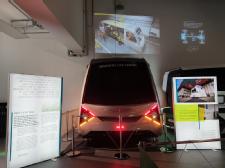 As well as showcasing the Coventry Very Light Rail Project, engineers from WMG’s Automation Systems Group have also created a display using a UR5 collaborative robot, or cobot, to show and explain how automation plays an important part in battery assembly and manufacturing.
As well as showcasing the Coventry Very Light Rail Project, engineers from WMG’s Automation Systems Group have also created a display using a UR5 collaborative robot, or cobot, to show and explain how automation plays an important part in battery assembly and manufacturing.
The cobot, which is the centrepiece of the display, was the brainchild of WMG Project Engineer Rohin Titmarsh. After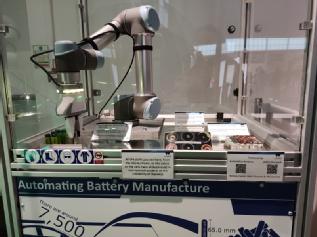 working on AMPLIFII , a research project which delivered novel and leading designs for high power and high energy modules, along with the manufacturing methods to deliver them to medium volume production, Rohin started to investigate ways to bring the project to life for a younger audience. The team collaborated with Schunk, suppliers of gripping systems for industrial robots, who have generously loaned a gripper to the team for use in this exhibition, highlighting WMG’s strength in industry and breath of partners we work with.
working on AMPLIFII , a research project which delivered novel and leading designs for high power and high energy modules, along with the manufacturing methods to deliver them to medium volume production, Rohin started to investigate ways to bring the project to life for a younger audience. The team collaborated with Schunk, suppliers of gripping systems for industrial robots, who have generously loaned a gripper to the team for use in this exhibition, highlighting WMG’s strength in industry and breath of partners we work with.
Rohin explains: “This project is a shining example of the fantastic ability we have between our research and technical teams, to help bring projects to life. I am very appreciative of the support of Engineering Technician, Bethany Haynes, and thankful to Phil Jemmett and Margaret Low in the Outreach Team for the opportunity and assistance to develop this extension of the ‘Battery Builder’ activity.
“It is always important to explain why automation is crucial in producing the number of batteries we need for the future. The ‘Battery Builder’ activity does that for school students by introducing robots in manufacturing, why we use them and some basics about programming them. The gamification of this activity means we’re communicating the key points about our research in a fun and engaging way. Being able to have a real cobot running in the museum is a fabulous example of modern day engineering and in turn a great way to inspire the next generation of young engineers
“We look forward to working with Schunk and other partners in the future on more exciting and innovative uses for cobots.”
Our Future Moves runs until 31st October 2021 - find out more here: Our Future Moves - Coventry Transport Museum (transport-museum.com)
Made Smarter launches £1.9 million digital scheme with WMG to help West Midlands SMEs
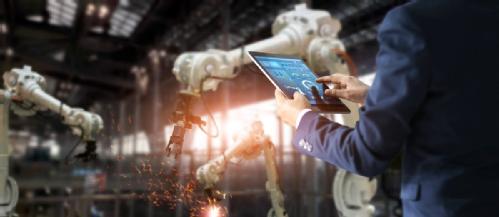 Made Smarter has launched a £1.9 million digital adoption push to drive growth in West Midlands manufacturing and engineering SMEs and help them boost productivity.
Made Smarter has launched a £1.9 million digital adoption push to drive growth in West Midlands manufacturing and engineering SMEs and help them boost productivity.
Digital experts will provide advice to businesses on how to switch to advanced and automated technologies as well as working to improve employees’ overall digital skills.
The Coventry and Warwickshire Local Enterprise Partnership (CWLEP) Growth Hub is leading the one-year Made Smarter scheme with its fellow Growth Hubs in Greater Birmingham and Solihull, the Black Country, Worcestershire Business Central, The Marches, and Stoke-on-Trent and Staffordshire on behalf of the West Midlands Combined Authority and the Department for Business, Energy and Industrial Strategy.
The West Midlands Growth Hubs are working closely with the West Midlands Combined Authority and their strategic partners WMG, at the University of Warwick and the Manufacturing Technology Centre (MTC) in Coventry to tap into the expertise of their digital manufacturing specialists.
Professor David Greenwood, CEO of WMG HVM Catapult centre, comments:
“Digitalisation for smaller companies needs a different approach than for larger companies. It isn’t about purchasing multi-million pound software systems – it’s about improvements in design tools, manufacturing, digitalising legacy plant and equipment and integration to supply chain systems.
“We are delighted to bring the expertise of WMG and the High Value Manufacturing Catapult to help transform the productivity of SMEs who are so critical to the West Midlands regional economy.”
Craig Humphrey, managing director of the CWLEP Growth Hub, said there are potentially 14,500 SME manufacturers in the region who could benefit from the National Made Smarter Movement. He said:
“All the Growth Hubs in the West Midlands are working together to contact SMEs in our areas who will benefit from this practical help.
“Digital technology can appear daunting and with the day-to-day efforts of owners and senior management teams to keep their businesses going during the pandemic, this kind of activity needs to be pushed to the upper end of their priorities.
“But we believe it is key to help SMEs in the advanced manufacturing and engineering sector to run more efficiently for their long-term future success.
“The Growth Hubs will be assessing each business that applies to make sure we provide them with the kind of specialist support they need, which in Coventry and Warwickshire could be in the fields of robotics and automation, and artificial intelligence since we are working with WMG and the MTC.
“We will then help SMEs to develop an action plan for adopting digital technology in their own detailed roadmap, which could involve participating in a leadership training programme, being offered a student placement, or receiving a match funded grant.
“The National Made Smarter Movement aims to entice SMEs that are not often reached through the usual business programmes and services, by transforming the digital tools within their companies, which in addition to upskilling their staff and creating jobs, will benefit the regional economy.”
Charlotte Horobin, Make UK Region Director – Midlands & East of England, said:
“The roll out of the Made Smarter Adoption programme across the West Midlands is great news for manufacturers, which we and our members welcome.
“Our 2020 Innovation Monitor highlighted that 18% of manufacturers in the West Midlands were not adopting industrial digital technologies, which we hope the programme will help address. Digital take-up will be key to boosting productivity as we come out of the current COVID crisis, creating more highly paid jobs and underpinning the region’s competitiveness.”
Neill Smith, Head of Manufacturing Support Services at the Manufacturing Technology Centre, said that the Made Smarter scheme perfectly complements its ongoing work to support manufacturing SMEs increase productivity, develop resilience, increase competitiveness and, ultimately, grow their business.
He said: “We help introduce digital systems to SMEs, that capture the right information at the right time, to enable them to make the right decisions and manage their companies more efficiently.
“From supporting the adoption of process control automation, robotics, and digitalisation tools, to helping SMEs with data or system integration and the adoption of augmented and virtual reality tools, we’re supporting companies to use digital data to drive digitally controlled equipment in the latest methods of manufacture.”
To register and find out more information, please visit http://bit.ly/MadeSmarterWestMidlands
ENDS
22 JUNE 2021
NOTES TO EDITORS
To find out more about MadeSmarter visit http://bit.ly/MadeSmarterWestMidlands
Made Smarter is a national movement to drive growth amongst UK makers and advance the UK economy. Backed by world renowned businesses and the UK government, it will improve the development and adoption of emerging technologies. Making a real, everyday difference to people from the boardroom to the factory floor.
Made Smarter was formed following a nationwide review into UK manufacturing that recommended three key changes: More ambitious leadership. More innovation in developing new technologies. And faster implementation and adoption of those technologies. We’ll be boosting the digital skills of industry leaders, bringing businesses and research development together to develop new technology, and helping makers embrace new digital tools. In doing so, we’ll inspire the next industrial revolution and make the UK a leader in digital technologies.
For further information please contact:
Alice Scott
Media Relations Manager - Science
University of Warwick
Tel: +44 (0) 7920 531 221
E-mail: alice.j.scott@warwick.ac.uk
Lead-acid battery lifespan to be increased for use in energy storage systems
· Lead-acid batteries are an established alternative to Li-ion batteries as they are simpler safer to use and are recyclable
· How to increase the lifespan and health of batteries will be researched by WMG, University of Warwick, in collaboration with Loughborough University. This research will make lead acid batteries stronger contender for both commercial and domestic energy storage systems
· Researchers will be using AI to optimise the batteries for energy storage solutions rather than focusing on the battery chemistry
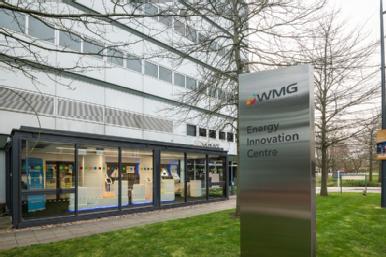 Energy storage systems (ESS) are used in decentralised and complex electricity networks; lead-acid batteries could be a clean and green option for ESS. Researchers from WMG University of Warwick and Loughborough University will investigate how to optimise the management of lead-acid batteries in ESS use.
Energy storage systems (ESS) are used in decentralised and complex electricity networks; lead-acid batteries could be a clean and green option for ESS. Researchers from WMG University of Warwick and Loughborough University will investigate how to optimise the management of lead-acid batteries in ESS use.
Europe’s energy storage transition over the last few years has witnessed tremendous growth, increasing from 0.55 GWh 2016 to 5.26 GWh by the end of 2020, with front-of-the-meter deployments such as those by utilities leading the way, representing more than 50% of installed capacity.
These energy storage systems require high-performing, reliable and affordable batteries to ensure the smooth generation and storage of energy for regional and national electrical grids.
The health and lifespan of lead-acid batteries will be optimised in the project HALO-SMART-ESS-LAB (Health and Lifespan Optimization with Smart Manager Algorithms and Recuperative Testing of Energy Storage Systems of Lead-Acid Batteries).
The aim of the project, which is funded by the Consortium for Battery Innovation (CBI), is to achieve significant improvements in cycle life and operational health of lead-acid batteries in energy storage systems (ESS), thereby opening new doors in integrating renewable energy sources into low carbon energy systems.
Extending the lifespan of the batteries will reduce the cost of the overall system, making lead batteries more attractive for domestic, commercial and industrial applications. As well as being cost effective, lead batteries are much safer than Li-ion batteries in terms of health and safety and fire hazards risks, and are widely and fully recyclable.
Researchers from WMG at the University of Warwick will be working with Loughborough University, to focus on application and system operation levels, rather than on internal battery chemistry or technology levels. Existing state-of-the-art battery types such as VRLA AGM batteries will be tested under different cycling profiles to explore in-depth:
· The use of appropriately spaced recuperative charging (overcharging)
· Deeper understanding of the ripple current effect on the ESS
· The use of additional on-line battery voltage monitoring or full BMS
· Applying deep learning algorithms and AI to achieve optimised control strategies decreasing wear-out and failure of battery modules.
Principal Investigator, Professor Richard McMahon from WMG, University of Warwick comments: “Energy Storage Systems are a key solution to more decentralised and complex electricity networks, as they can support their stability and maximise the utilisation of renewable generation capacity. We are therefore looking at how we can maximise the cycle life of lead-acid batteries to get the most out of them and make them cheaper and greener for all kinds of renewable energy uses.”
Professor Dani Strickland from Loughborough University adds:
“The availability of low-cost powerful microprocessors is fuelling an explosion in our capability to monitor, understand and impact battery degradation in real world situations at low cost. This project is exciting because it will use expertise in the partner organisations to transition lead acid batteries to the world of big data and smart energy storage.”
CBI’s Technical Manager, Dr Matt Raiford, said: “This kind of collaborative research with universities is exactly what the lead battery industry needs. Working with leading institutions to deliver new insights and modelling techniques for lead battery energy storage is critical for the wider industry to continue their foray into the utility grid storage market.”
ENDS
7 JUNE 2021
NOTES TO EDITORS
High-res images available at:
https://warwick.ac.uk/services/communications/medialibrary/images/may_2021/mcmahon_1.jpg
Caption: Isolated multichannel battery and cell voltage measuring circuit for use in series strings
Credit: WMG, University of Warwick
Video available to view at: https://biteable.com/watch/2966892/32fa5ade7e8821ec12ec53c21b9b57e4
For further information please contact:
Alice Scott
Media Relations Manager – Science
University of Warwick
Tel: +44 (0) 7920 531 221
E-mail: alice.j.scott@warwick.ac.uk

